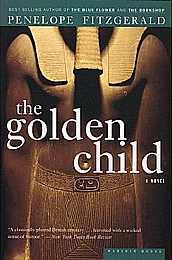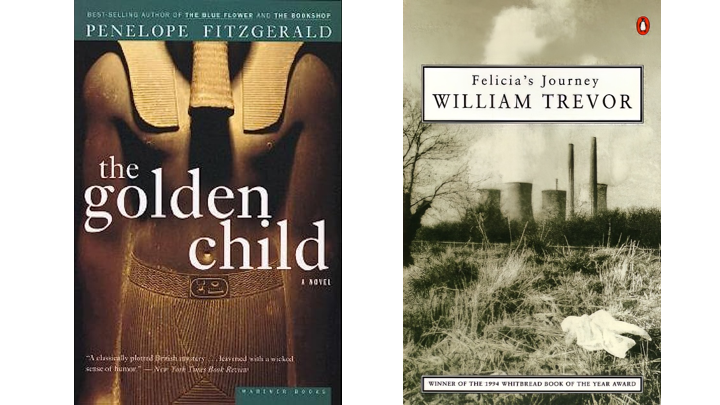In Part 17 of Food in Literature, Helen brings us extracts from two murder mysteries, The Golden Child by Penelope Fitzgerald and Felicia’s Journey by William Trevor, in which food is used to establish character.
The Golden Child: Penelope Fitzgerald
 Set in the museum world and published in 1977, this is an erudite, wickedly funny murder mystery.
Set in the museum world and published in 1977, this is an erudite, wickedly funny murder mystery.
The hero Waring Smith is obliged to take his boss' secretary out for an early supper after work.
The restaurant, having been formerly called The Bloomsbury Group, Lytton Strachey Slept Here, The Cook Inn, Munchers and Bistro Solzhenitzyn, now bore the name of The Crisis. It was so small and hot that it was a matter for astonishment that anyone should want to enter it. The day’s menu, although the same as every day’s, was scrawled, in an apparently improvised manner, in chalk on a blackboard: the writing was so crowded that neither the names nor the enormous prices could be read in the dim light afforded by candles stuck with their own grease on its wooden boards. Ambisexual waiters in white trousers scrimmaged like gondoliers in midstream among the rocking tables and placed on the sacking tablecloths wicker basketfuls of coarse prison bread and tiny carafes containing a few mouthfuls of rosé, compounded of dregs from the glasses of the larger restaurant next door.
Waring and Dousha saw nothing to criticise and were prepared to enjoy themselves. Waring propelled Dousha forward by main force towards the table at the back of the room which was so inconvenient, being jammed under an Edwardian coat stand, that it was still left empty.
Tacking after Dousha’s ample figure through a trail of cutlery which her drapery swept from the gimcrack tables, he felt reduced to a nonentity. But how different it was when she subsided, with a smile so broad it might almost have been a laugh. “This is nice”, she said, looking contentedly through the reeking haze. It was not, but Dousha made it seem so.
Waring stared at the blackboard. “Let me try and order something for you,” he said, “I promised Sir William I’d look after you properly.”
The menu alternated strangely between French and Old English, Boeuf en Daube being followed by the mysterious Dollops.
Dousha reveals that she is pregnant and then:
… (she) settled back in her creaking chair and ordered snails, tripe allegedly cooked in cream and suet pudding with treacle.
Felicia’s Journey: William Trevor
 On one level this novel is also a murder mystery and William Trevor, like Penelope Fitzgerald, is also a master. But there the resemblance, certainly between these two extracts, ends.
On one level this novel is also a murder mystery and William Trevor, like Penelope Fitzgerald, is also a master. But there the resemblance, certainly between these two extracts, ends.
Felicia is an innocent girl, who falls in love and allows herself to be seduced by a young man from her village in Ireland. She falls pregnant, he has left for England, she has no forwarding address and so she catches the ferry to England and tries to find him. She gets picked up by Mr Hilditch a gross pervert, who persuades her that he is a kindly soul, who wants to help her find her boyfriend.
Hilditch works as catering manager in a factory, the perfect job for him, as he:
… enjoys eating. Often, considering that he has not consumed sufficient during the course of a meal, he treats himself to a Bounty bar or a Mars or a packet of biscuits. The appreciation of food, he calls it privately.
The food that he eats is heavy in fat and sugar and the descriptions of what he chooses to gorge himself on and when forms a large part of the way that William Trevor develops his sinister and repulsive character. For example, this:
Grilling the steak he bought in Tesco’s on the way back to his house, draining potatoes and the Brussels sprouts, he effortlessly keeps the girls' features in his consciousness. He lays the table in the dining room, carrying in salt and pepper and a few slices of Mother’s Pride on a side plate. He always eats in the dining room in the evenings.
While waiting for the steak to grill, he scoops two individual trifles on to a plate, pours cream over them and sprinkles a spoonful of caster sugar. He carries the trifles to his long mahogany table, carrying, as well, his biscuit tin—raspberry creams and coffee creams, chocolate digestives, fig rolls, a couple of KitKats.
Or this:
Mr Hilditch eats alone in his dining room: a Fray Bentos steak and kidney pie with all the trimmings, a couple of slices of Mother’s Pride, pineapple chunks, condensed milk heated up, tea.
It would be an interesting exercise to list how food choices have been used in literature to describe character.


